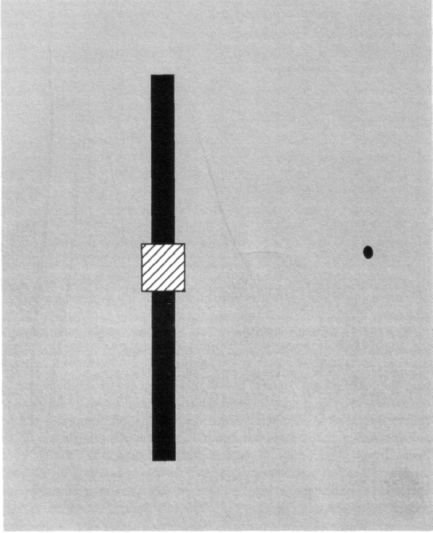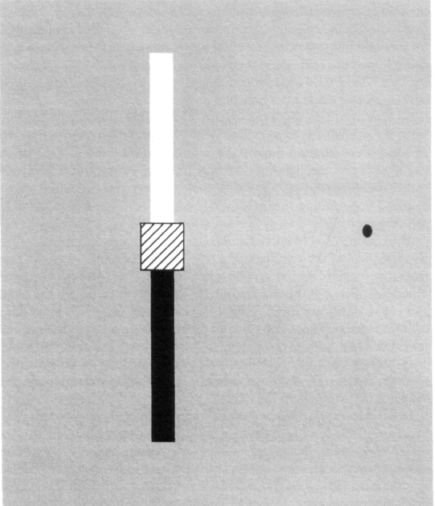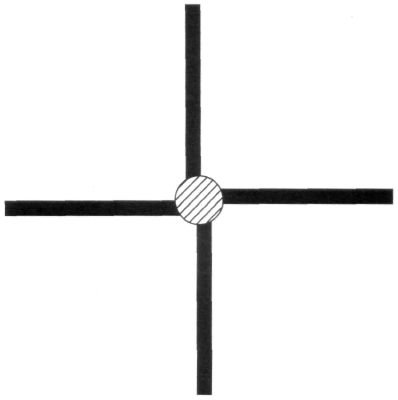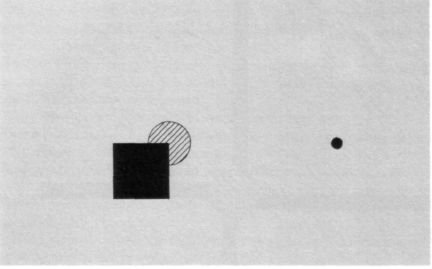Read Phantoms in the Brain: Probing the Mysteries of the Human Mind Online
Authors: V. S. Ramachandran,Sandra Blakeslee
Tags: #Medical, #Neurology, #Neuroscience
Phantoms in the Brain: Probing the Mysteries of the Human Mind (17 page)

What does it actually feel like to have a scotoma? With most brain disorders you have to remain content with a clinical description, but you can get a clear sense of what is going on in migraine sufferers by simply examining your own blind spot. The existence of this natural blind spot of the eye was actually predicted by the seventeenth−century French scientist Edme Mariotte. While dissecting a human eye, Mariotte noticed the optic disk—the area of the retina where the optic nerve exits the eyeball. He realized that unlike other parts of the retina, the optic disk is not sensitive to light. Applying his knowledge of optics and eye anatomy, he deduced that every eye should be blind in a small portion of its visual field.
You can easily confirm Mariotte's conclusion by examining the illustration of a hatched disk on a light gray background (Figure 5.2). Close your right eye and hold this book about a foot away from your face and fixate your gaze on the little black dot on the page. Concentrate on the dot as you slowly move the page toward your left eye. At some critical distance, the hatched disk should fall within your natural blind spot and disappear completely!3 However, notice that when the disk disappears, you do not experience a big black hole or void in its place. You simply see this region as being "colored" by the same light gray background as the rest of the page—another striking example of filling in.4
You may be wondering why you've never noticed your blind spot before now. One reason is related to binocular vision, which you can test for yourself. After the hatched disk has disappeared, try opening the other eye and you will see that the disk pops back instantly into view. This happens because when both eyes are open the two blind spots don't
Figure 5.2
Blind spot demonstration. Shut your rißht eye and look at the black dot on the right with your left
eye. From about one and a half feet away, move the book slowly toward you. At a critical distance the
circular hatched disk on the left will fall entirely on your blind spot and disappear completely. If you move the
65
book closer still, the disk will reappear. You may need to "hunt" for the blind spot by moving the book to and
fro several times until the disk disappears.
Notice that when the disk disappears you don't see a dark void or hole in its place. The region is seen as being
covered with the same light gray color as the background. This phenomenon is loosely referred to as "filling
in. "
overlap; the normal vision of your left eye compensates for the right eye's blind spot and vice versa. But the surprising thing is that even if you close one eye and glance around the room, you are still not aware of the blind spot unless you carefully look for it. Again, you don't notice the gap because your visual system obligingly fills in the missing information.5
But how sophisticated is this filling−in process? Are there clear limits as to what can be filled in and what cannot? And would answering this question give us hints about what type of neural brain machinery may be involved in allowing it to happen?
Bear in mind that the filling in is not just some odd quirk of the visual system that has evolved for the sole purpose of dealing with the blind spot. Rather, it appears to be a manifestation of a very general ability to construct surfaces and bridge gaps that might be otherwise distracting in an image—the same ability, in fact, that allows you to see a rabbit behind
a picket fence as a complete rabbit, not a sliced−up one. In our natural blind spot we have an especially obvious example of filling in—one that provides us with a valuable experimental opportunity to examine the
"laws" that govern the process. Indeed, you can actually discover these laws and explore the limits of filling in by playing with your own blind spot. (To me, this is one reason the study of vision is so exciting. It allows anyone armed with a sheet of paper, a pencil and some curiosity to peer into the inner workings of his own brain.)
First, you can decapitate your friends and enemies, using your natural blind spot. Standing about ten feet away from the person, close your right eye and look at his head with your left eye. Now, slowly start moving your left eye horizontally toward the right, away from the person's head, until your blind spot falls directly on his head. At this critical distance, his head should disappear. When King Charles II, the "science king" who founded the Royal Society, heard about the blind spot, he took great delight in walking around in his court decapitating his ladies in waiting or beheading criminals with his blind spot before they were actually guillotined. I must confess I sometimes sit in faculty meetings and enjoy decapitating our departmental chairman.
Next we can ask what will happen if you run a vertical black line through your blind spot. Again, close your right eye and stare at the black spot to the right of the picture (Figure 5.3) with your left eye. Then move the page gradually to and fro until the small hatched square on the center of the vertical line falls exactly inside your left eye's blind spot. (The hatched square should now disappear.) Since no information about this central portion of the line—falling on the blind spot—is available to the eye or the brain, do you perceive two short vertical lines with a gap in the middle, or do you "fill in" and see one continuous line? The answer is clear.
You will always see a continuous vertical line. Perhaps neurons in your visual system are making a statistical estimate; they "realize" that it is extremely unlikely that two different lines are precisely lined up on either side of the blind spot in this manner simply by chance. So they "signal" to higher brain centers that this is probably a single continuous line. Everything that the visual system does is based on such educated guesswork.
But what if you try to confound the visual system by presenting internally contradictory evidence—for instance, by making the two line segments differ in some way? What if one line is black and the other is white 66

(shown on a gray background)? Does your visual system still regard these two dissimilar segments as being parts of a single line and proceed to complete it? Surprisingly, the answer is again yes. You will see a con−
Figure 5.3
A vertical black line running through the blind spot. Repeat the procedure described for Figure
5.2. Shut your right eye, look at the small black dot on the right with your left eye and move the page to and
fro until the hatched square on the left falls on your blind spot and disappears. Does the vertical line look
continuous, or does it have a gap in the middle? There is a lot of variation from person to person, but most
people "complete" the line. If the illusion doesn't work for you, try aiming your blind spot at a single
black−white edge (such as the edge of a black book on a white background) and you will see it complete.
67

Figure 5.4
The upper half of the line is white and the lower half black. Does your brain complete the vertical
line in spite of this internally contradictory evidence7.
tinuous single straight line, black on top and white below, but smeared in the middle into a lustrous metallic gray (Figure 5.4). This is the compromise solution that the visual system seems to prefer.
People often assume that science is serious business, that it is always "theory driven," that you generate lofty conjectures based on what you already know and then proceed to design experiments specifically to test these conjectures. Actually real science is more like a fishing expedition than most of my colleagues would care to admit. (Of course, I would never say this in a National Institutes of Health [NIH] grant proposal, for most funding agencies still cling to the naive belief that science is all about hypothesis testing and then carefully dotting the "i's" and crossing the "t's." God forbid that you should just try to do something entirely new that's just based on a hunch!)
So let's continue our experiments on your blind spot, just for fun. What if you challenged your visual system by deliberately misaligning the two half lines—shifting the top line segment to the left and the bottom line segment to the right? Would you then see a complete line anyway with a kink in the middle? Would you connect the two lines with a diagonal line running through the blind spot? Or would you see a big gap (Figure 5.5)?6
Most people do complete the missing line segment, but the astonishing thing is that the two segments now 68

appear collinear—they get perfectly lined up to form a vertical straight line! Yet if you try the same experiment using two horizontal lines—one on either side of the blind spot—you don't get this "lining−up"
effect. You either see a gap or a big kink—the two lines don't fuse to form a horizontal straight line. The reason for the difference—lining up vertical lines but not horizontal lines—is not clear, but I suspect that it has something to do with stereoscopic vision: our ability to extract the tiny differences between the image of the two eyes to see depth.7
How "clever" is the mechanism that completes images across the blind spot? We have already seen that if you aim your blind spot at somebody's head (so that it vanishes), your brain doesn't replace the missing head; it remains chopped off until you look off to one side so that the head falls on the normal retina once again. But what if you used much simpler shapes than heads? For example, you could try "aiming" your blind spot at the corner of a square (Figure 5.6). Noticing the other three corners, does your visual system fill in the missing corner? If you try this experiment, you will notice that in fact the corner disappears or looks "bitten off" or smudged. Clearly the neural machinery that allows completion across the blind spot cannot deal with corners; there's a limit to what can and what cannot be filled in.8
Completing a corner is obviously too big a challenge for the visual system; perhaps it can cope only with very simple patterns such as homogeneous colors and straight lines. But you're in for a surprise. Try aiming your blind spot at the center of a bicycle wheel with radiating
Figure 5.5
Repeat the experiment, "aiming" your blind spot at a pattern that resembles a swastika
—
an
ancient Indo−European peace symbol. The lines are deliberately misaligned, one on either side of the blind
spot.
Many people find that when the central hatched disk disappears, the two vertical lines get "lined up" and
become collinear, whereas the two horizontal lines are not lined up
—
there is a slight bend or kink in the
middle.
69

